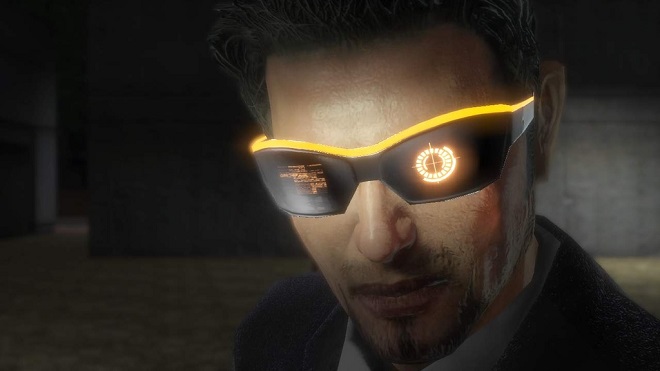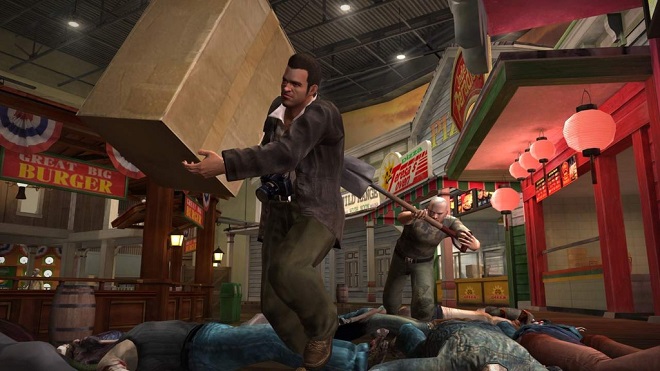Cognition Dissemination: If Only Frame City Killer Released 15 Years Ago

Microsoft and their third-party partners promoted a respectable slate of titles for the Xbox 360’s first year and the period slightly beyond then, games within a variety of genres and budgets. One among them that’s been on my mind recently is Namco’s Frame City Killer, development for which was cancelled just over 15 years ago. Little did anyone realize at the time that this would mark the end of an era for a certain crop of Japanese games.
Frame City Killer was far from the best-looking game advertised during the 360’s earliest years, but it was among the most interesting in concept, particularly for anyone who liked slightly offbeat and gloriously cheesy Japanese games. It focused on a man simply named Crow (a codename… maybe), an assassin tasked with identifying an eliminating a terrorist named Khan, the head of the most dangerous drug cartel in Frame City. Should Crow have succeeded in his assignment, he would have been a, well, Frame City Killer. The title’s name is derived from a clear source, unless an unforeseen twist was planned along the way.

Frame City Killer had the makings of a sleeper hit. One of the biggest highlights shown through the trailers was the ridiculous (in a mostly good way) dialogue that accompanied its solid voice acting, the kind that would make for a story that would hardly be considered riveting, yet entertaining enough. The same could be said of its gameplay, with shooting and hand-to-hand combat that looked fine enough to keep the game interesting. It would have been considered an interesting experiment if we got to play it. Its numerous delays hinted at a troubled development cycle, and the press wasn’t impressed, which led to Namco no longer wanting to take a risk on it.
There was more importance to the cancellation of Frame City Killer, looking back on it now. As I mentioned above, its burial spelled bad news for a whole style of games: Japanese games with mid-tier budgets inspired by western settings made for a worldwide audience. This particular title is simply the most identifiable example of one that didn’t come to pass.
Namco as a whole fell victim to this trend, beyond Frame City Killer, after releasing games like Urban Reign and Breakdown in the preceding generation (the PlayStation 2, Xbox, and GameCube era, specifically). The developer had concepts for three PlayStation 3 games, including a third-person game with a Metal Gear Solid 4-style color palette known as Brave Arms, a first-person likely-seasonal game known as Second: Season 1, and an action-adventure game known as Chain Limit. These concepts were pitched by Project ACES (of the Ace Combat franchise) and were planned to be collaborations with Cellius, a now-defunct company formed by Ken Kutaragi after he left Sony Japan that Bandai Namco and Sony both held shares in. The concepts were openly discussed, printed, and detailed in Japan’s Famitsu magazine because they were never realized. It’s possible Namco’s merger with Bandai had something to do with this, which reportedly led to a stricter game development green lighting process.

Not to say games of this type weren’t released during the PS3 and 360 generation — they were just smaller in numbers. Capcom provided the biggest examples through franchise starters Dead Rising and Lost Planet, though the games reportedly had to be green lit after producer Keiji Inafune deliberately went overbudget with their prototypes, to a point that the higher-ups had to green light for full development them if they wanted to profit. This is the kind of move only a company veteran of Inafune’s or Shinji Mikami’s stature could have gotten away with. Both are notably long gone from the company these days, and both franchises lie in purgatory.
There were other examples too, good and bad. Deadly Premonition was one of the more popular examples, a game from Access Games and directory Swery65 heavily inspired by Twin Peaks. Binary Domain was another one, though it came later in the generation, and with apparent sales that showed why developers largely abandoned this style of game. Examples on the other side of the fence didn’t help, like MindJack and Quantum Theory from Square Enix and Koei Tecmo, respectively, which convinced some among the gaming audience that games with western settings made for the world had worn out their welcome. Bad examples of games in this style existed before the PS3/360 generation, but they stuck out and hurt more with the reduced number of overall releases.

Plenty of Japanese games are still being made, but the non-Nintendo ones that take off in western territories now tend to either have Japan-centric content, anime trappings, or fantasy settings. The Yakuza series, Persona series, and the Souls series are, respectively, are the top franchises representing each of those settings. (The last one could qualify as a western-centric one given the dark medieval European fantasy setting, but it’s notably different from the examples laid out in above paragraphs.) Those are all great, but they aren’t replacements for games with settings like Frame City Killer listed above. The games of that type are only getting rarer over time.
I’m having trouble imagining a future where games in the style of Frame City Killer and others will resurface and regain even the smallest level of prominence, and I’m having trouble thinking of any upcoming examples of the type. There’s a chance that we’ll receive an occasional one, but I can’t emphasize “chance” enough.





